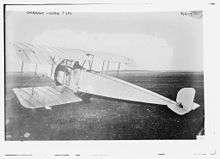Gotha LD 5
The Gotha LD 5 (for Land Doppeldecker - "Land Biplane") was a military aircraft produced in Germany during the early part of World War I.
| LD 5 | |
|---|---|
 | |
| Role | Military utility aircraft |
| National origin | Germany |
| Manufacturer | Gotha |
| First flight | 1914 |
| Primary user | Luftstreitkräfte |
| Number built | 6 |
Development
Developed to the Kavallerie Flugzeug requirement for light fast scaouting aircraft, the LD 5 was used for training and reconnaissance, it was a conventional design with two-bay unstaggered wings, tailskid landing gear, and a single open cockpit. Flight tests showed it to be unable to live up to intended reconnaissance duties and so the LD 5 was relegated to being a trainer. The LD 5's short wings also rendered it confined to long runways, but the LD 5 was ordered into modest production despite deficiencies.
Specifications (LD 5)

rear side view showing the single cockpit
Data from [1]
General characteristics
- Crew: 1
- Length: 5.8 m (19 ft 0 in)
- Wingspan: 8.7 m (28 ft 7 in)
- Empty weight: 385 kg (849 lb)
- Powerplant: 1 × Oberursel U.I 9-cylinder air-cooled rotary piston engine, 75 kW (100 hp)
- Propellers: 2-bladed fixed-pitch propeller
Performance
- Maximum speed: 115 km/h (71 mph, 62 kn)
- Cruise speed: 105 km/h (65 mph, 57 kn)
gollark: I don't SEE any unclosed ones.
gollark: I either fixed or worsened it.
gollark: <@!293066066605768714> new onstat?
gollark: I see.
gollark: I don't know what that is?
References
| Wikimedia Commons has media related to Gotha LD.5. |
Further reading
- Gray, Peter; Thetford, Owen (1970). German Aircraft of the First World War (2nd ed.). London: Putnam. p. 394. ISBN 0-370-00103-6.
This article is issued from Wikipedia. The text is licensed under Creative Commons - Attribution - Sharealike. Additional terms may apply for the media files.